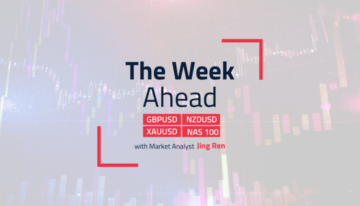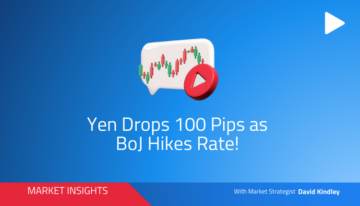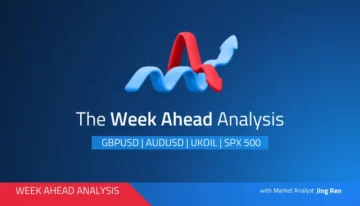Economists are more optimistic about how many jobs were created in the US last month. But, that might be an over-correction from consistently underestimating the resilience of the labor market this year. But, there are other factors that make predicting Friday’s release a little more difficult, meaning there is more chance for volatility in the markets.
Because of the holidays earlier in the week, several key pre-NFP labor data points have been delayed. That includes ADP and JOLTS numbers. The latter is particularly important because of why the number of jobs has been consistently underestimated. All of this feeds into expectations for what the Fed might do in the coming meetings, as focus now switches to the labor market.
Why are they wrong so often?
The US labor market is in a somewhat unique situation, which we’ve been talking about all year. The number of open job spots far exceeds the number of people looking for work. That means that NFP numbers don’t depend so much on economic factors, as personal decisions, which can be more arbitrary.
For example, the unemployment distribution in the US is not even. Nebraska has an unemployment rate of 1.9%, and, along with the Dakotas is desperate for workers. California and the District of Columbia have the highest unemployment rates, with few job opportunities. But, people are reluctant to move from the cities to the rural areas where there are vacancies. Just how many people decide to uproot and move isn’t a factor that is consistent, or economically predictable, since the reasons for staying or moving are often personal.
Future trends
The last JOLTS release showed that the number of open jobs actually increased, widening the gap between openings and seekers. If that pattern persisted through late spring, then that could exaggerate the problem of accurately predicting the NFP number this time around.
The other factor is the Fed, which so far has been focused almost exclusively on inflation. That is, ignoring the second part of its mandate on maintaining full employment. The jobless rate has been pretty consistently below structural level, leading to tightness in the labor market. That pushes up labor costs, which can translate to persistently high inflation. This is a problem that Fed officials are increasingly talking about, and could indicate that the Fed will keep hiking even as inflation comes closer to target.
What the data says
The consensus is that June NFP will come in at 250K, below the 339K reported in the prior month. But the unemployment rate is expected to remain steady at 3.7%, with an unchanged participation rate.
Where focus could be turning to is the average hourly earnings, which are forecast to show growth of 4.1% annual, compared to 4.3% prior. The issue is that inflation was last reported at 4.0%, meaning that labor costs could soon be rising faster than inflation. The Fed is likely to see that as a problem, and therefore markets could react more to this figure. Higher labor costs would imply a higher chance of Fed hikes in the future.
Trading the news requires access to extensive market research – and that’s what we do best.
- SEO Powered Content & PR Distribution. Get Amplified Today.
- PlatoData.Network Vertical Generative Ai. Empower Yourself. Access Here.
- PlatoAiStream. Web3 Intelligence. Knowledge Amplified. Access Here.
- PlatoESG. Automotive / EVs, Carbon, CleanTech, Energy, Environment, Solar, Waste Management. Access Here.
- BlockOffsets. Modernizing Environmental Offset Ownership. Access Here.
- Source: https://www.orbex.com/blog/en/2023/07/will-analysts-get-nfp-right-this-time
- :has
- :is
- :not
- :where
- $UP
- 1
- a
- About
- access
- accurately
- actually
- adp
- All
- along
- an
- Analysts
- and
- app
- ARE
- areas
- around
- AS
- At
- BE
- because
- been
- below
- BEST
- between
- Blog
- but
- california
- CAN
- Chance
- Cities
- closer
- Columbia
- come
- comes
- coming
- compared
- Consensus
- consistent
- Costs
- could
- created
- data
- data points
- decide
- decisions
- Delayed
- difficult
- distribution
- district
- do
- Dont
- Earlier
- Earnings
- Economic
- employment
- Ether (ETH)
- Even
- example
- exceeds
- exclusively
- expectations
- expected
- extensive
- factor
- factors
- far
- faster
- Fed
- fed hikes
- few
- Figure
- Focus
- focused
- For
- Forecast
- forex
- Forex Trading
- from
- full
- future
- gap
- get
- Growth
- Have
- High
- High inflation
- higher
- highest
- Hikes
- hiking
- holidays
- How
- HTTPS
- if
- image
- important
- in
- includes
- increased
- increasingly
- indicate
- inflation
- into
- issue
- ITS
- Job
- Job Opportunities
- Jobs
- june
- just
- Keep
- Key
- labor
- labor market
- Last
- Late
- leading
- Level
- likely
- little
- live
- looking
- maintaining
- make
- mandate
- many
- many people
- Market
- market research
- Markets
- meaning
- means
- meetings
- might
- Mobile
- Mobile app
- Month
- more
- move
- moving
- much
- Nebraska
- news
- nfp
- now
- number
- numbers
- of
- officials
- often
- on
- open
- openings
- opportunities
- Optimistic
- or
- Other
- part
- participation
- particularly
- Pattern
- People
- persistently
- personal
- plato
- Plato Data Intelligence
- PlatoData
- points
- Predictable
- predicting
- pretty
- Prior
- Problem
- pushes
- Rate
- Rates
- React
- reasons
- release
- remain
- Reported
- requires
- research
- resilience
- right
- rising
- Rural
- Rural Areas
- s
- Second
- see
- several
- show
- showed
- since
- situation
- So
- so Far
- somewhat
- Soon
- spring
- steady
- structural
- talking
- Target
- than
- that
- The
- the Fed
- The Future
- then
- There.
- therefore
- they
- this
- this year
- Through
- time
- to
- Trading
- translate
- Turning
- unemployment
- unemployment rate
- unique
- URL
- us
- Volatility
- was
- we
- week
- were
- What
- which
- will
- with
- Work
- workers
- would
- Wrong
- year
- zephyrnet













